NOTES
Friday, June 29, 2007
June 29, 2007
07:00 White sky, low fog, still
Unbanded (Shopper, I suspect) arrives first this morning. Close behind follows blue/purple-metal/purple landing with a loud rattle in the crabapple. Pia has taught me the rattle is a call made only by a female bird. My experience tells me the call is used to define territory. So far, I’ve only heard it when other birds are around. Bp/mp thinks this is her place. Last year’s juvenile, and banded here, I believe she’s a likely daughter of my resident pair. They both tolerate her presence and will feed next to her. She is small, dainty, and has a regal way of stretching her body out tall, turning her head to look all around her. She is a frequent visitor to the feeder and brings her mate, unbanded. Pia says their fledglings can be seen along the trail between the P.E. building and the back of Founder’s Hall. They are a “campus pair.”
Metal/white-blue/blue, one of my very favorite birds, comes next. One day he hopped right into my bedroom when the sliding glass door was open—just checking to see if there were any peanuts on the carpet. He is by far the tamest of birds, will come to within an arm’s length of me and grab peanuts. His fearlessness gives him a feeding advantage over all the other birds. So far this morning, I haven’t seen his mate, mo/bo. I think I remember they own the “secret garden” feeder on campus, though I must check to be sure. It seems to me Pia told me this bird has been around for nine years. I’ll have to check on that too. I suspect mo/bo is nesting because she was here regularly just a few weeks ago, and I haven’t seen her since I started these notes.
A one-banded juvenile flies to the bench and takes a peanut. It has a pink gape, fluffy feathers on its lower body, and looks small, awkward in its jerky movements. Its landings are uncertain, unbalanced. The band looks burnished—I wonder, has Pia begun banding juveniles? And if so, where was this bird banded and who was around?
Resident female arrives, her left foot curled up, toes deformed, looking very swollen and sore from leg mites. Her mate, Mr. Go, is right behind her chirping, bill opening and closing, flapping his wings while standing in position. It looks like begging to me, but must be a territorial display.
Today I sorted all the single-seed peanuts into one pile. I’m curious, like my cousin Charlotte who watches the scrub jays in Lake County, what criteria the birds use when they are “shopping” for the right peanut. So far, no one has selected a one-peanut shell.
Metal/blue-red/green flies to the feeder, goes clear in towards the back, shops--picking up/putting down--brings a few peanuts forward in the trap, then flies off. At 7:30, activity is picking up, birds flying in, one after another, landing on tree branches, hopping from look-out to look-out, jockeying for key positions. It would take more than one person, or someone more experienced than I, to sort out who’s chasing whom.
Unbanded juvenile pecks for seed underneath the feeder, one tiny millet seed at a time; it hardly seems possible enough nutritional content could be gathered to sustain growth. This bird must still rely on its parents for sustenance. Could it be a sibling of banded juve? They look similar in age—other than the band, I couldn’t tell them apart. This new juve now sits on a tree branch begging—body crouched low, wings fluttering fast, bill up in the air, calling. It flies to the deck, picks up one small seed at a time, grabs a peanut and flies. Mb/rg and mw/bb are both near by. It’s hard to tell if one of the adults is more significant than the other. Unbanded and Mr. Go are also near. The two juves share the bench and I realize the banded bird does look older than the unbanded. I wonder if I can get a picture of the two of them? Time out. Yes! I got some shots.
Unbanded juvie comes back and feeds on the bench right next to unbanded male. Could this be the offspring of bp/mp? This unbanded male has significant status at the feeder and is often seen efficiently chasing others off.
Mw/rg, is new on the scene today. Bp/mp picks seeds off the deck. Unbanded swoops in and she (bp/mp) rattles loudly. Unscathed, the two look for peanuts side-by-side. Unbanded with the right shoulder tuft arrives.
In the meantime, Mr. Rat has returned—he’s more surreptitious than Chippy, the Douglas Squirrel, or the Raccoons—and as much as he’d like a peanut, he scurries the moment he sees me. I will be hard pressed to get a picture of him in the trap. The chickadees are calling now, hopping through the back screen of the feeder, picking up seed. They look smaller than I remember them—could they be this year’s juveniles?
Mr/gw has a little trouble negotiating the edge of the trap—seems a little inexperienced here, but prefers the trap to the peanuts on the ground. Mb/ow flies in from the west--in and out again. Pb/mr flies in and feeds next to Mr. Go. He displays and she opens and closes her bill in a submissive gesture. I think I remember she was banded here last year too. I wish I knew the geneology; I’m curious about her relationship to Resident Male. Could she be pb/mp’s sister?
At one point this morning, there were more unbanded birds than I could keep track of. One, in particular, was interesting—barely pink gape and some tail feathers that were solid black, others striped with blue. Perhaps this is an older juvenile bird.
End time: 09:30
Total Birds: 12+
07:00 White sky, low fog, still
Unbanded (Shopper, I suspect) arrives first this morning. Close behind follows blue/purple-metal/purple landing with a loud rattle in the crabapple. Pia has taught me the rattle is a call made only by a female bird. My experience tells me the call is used to define territory. So far, I’ve only heard it when other birds are around. Bp/mp thinks this is her place. Last year’s juvenile, and banded here, I believe she’s a likely daughter of my resident pair. They both tolerate her presence and will feed next to her. She is small, dainty, and has a regal way of stretching her body out tall, turning her head to look all around her. She is a frequent visitor to the feeder and brings her mate, unbanded. Pia says their fledglings can be seen along the trail between the P.E. building and the back of Founder’s Hall. They are a “campus pair.”
Metal/white-blue/blue, one of my very favorite birds, comes next. One day he hopped right into my bedroom when the sliding glass door was open—just checking to see if there were any peanuts on the carpet. He is by far the tamest of birds, will come to within an arm’s length of me and grab peanuts. His fearlessness gives him a feeding advantage over all the other birds. So far this morning, I haven’t seen his mate, mo/bo. I think I remember they own the “secret garden” feeder on campus, though I must check to be sure. It seems to me Pia told me this bird has been around for nine years. I’ll have to check on that too. I suspect mo/bo is nesting because she was here regularly just a few weeks ago, and I haven’t seen her since I started these notes.
A one-banded juvenile flies to the bench and takes a peanut. It has a pink gape, fluffy feathers on its lower body, and looks small, awkward in its jerky movements. Its landings are uncertain, unbalanced. The band looks burnished—I wonder, has Pia begun banding juveniles? And if so, where was this bird banded and who was around?
Resident female arrives, her left foot curled up, toes deformed, looking very swollen and sore from leg mites. Her mate, Mr. Go, is right behind her chirping, bill opening and closing, flapping his wings while standing in position. It looks like begging to me, but must be a territorial display.
Today I sorted all the single-seed peanuts into one pile. I’m curious, like my cousin Charlotte who watches the scrub jays in Lake County, what criteria the birds use when they are “shopping” for the right peanut. So far, no one has selected a one-peanut shell.
Metal/blue-red/green flies to the feeder, goes clear in towards the back, shops--picking up/putting down--brings a few peanuts forward in the trap, then flies off. At 7:30, activity is picking up, birds flying in, one after another, landing on tree branches, hopping from look-out to look-out, jockeying for key positions. It would take more than one person, or someone more experienced than I, to sort out who’s chasing whom.
Unbanded juvenile pecks for seed underneath the feeder, one tiny millet seed at a time; it hardly seems possible enough nutritional content could be gathered to sustain growth. This bird must still rely on its parents for sustenance. Could it be a sibling of banded juve? They look similar in age—other than the band, I couldn’t tell them apart. This new juve now sits on a tree branch begging—body crouched low, wings fluttering fast, bill up in the air, calling. It flies to the deck, picks up one small seed at a time, grabs a peanut and flies. Mb/rg and mw/bb are both near by. It’s hard to tell if one of the adults is more significant than the other. Unbanded and Mr. Go are also near. The two juves share the bench and I realize the banded bird does look older than the unbanded. I wonder if I can get a picture of the two of them? Time out. Yes! I got some shots.
Unbanded juvie comes back and feeds on the bench right next to unbanded male. Could this be the offspring of bp/mp? This unbanded male has significant status at the feeder and is often seen efficiently chasing others off.
Mw/rg, is new on the scene today. Bp/mp picks seeds off the deck. Unbanded swoops in and she (bp/mp) rattles loudly. Unscathed, the two look for peanuts side-by-side. Unbanded with the right shoulder tuft arrives.
In the meantime, Mr. Rat has returned—he’s more surreptitious than Chippy, the Douglas Squirrel, or the Raccoons—and as much as he’d like a peanut, he scurries the moment he sees me. I will be hard pressed to get a picture of him in the trap. The chickadees are calling now, hopping through the back screen of the feeder, picking up seed. They look smaller than I remember them—could they be this year’s juveniles?
Mr/gw has a little trouble negotiating the edge of the trap—seems a little inexperienced here, but prefers the trap to the peanuts on the ground. Mb/ow flies in from the west--in and out again. Pb/mr flies in and feeds next to Mr. Go. He displays and she opens and closes her bill in a submissive gesture. I think I remember she was banded here last year too. I wish I knew the geneology; I’m curious about her relationship to Resident Male. Could she be pb/mp’s sister?
At one point this morning, there were more unbanded birds than I could keep track of. One, in particular, was interesting—barely pink gape and some tail feathers that were solid black, others striped with blue. Perhaps this is an older juvenile bird.
End time: 09:30
Total Birds: 12+
Subscribe to:
Post Comments (Atom)
Pia Sets the Trap
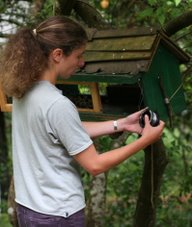
07/24/07
Peaking...
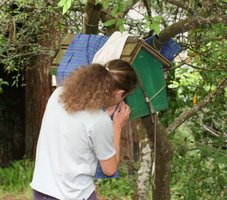
07/24/07
Oops, wrong bird!
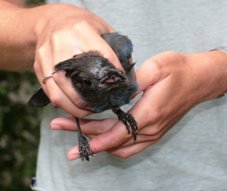
Demonstrating the "hold"
Try Again
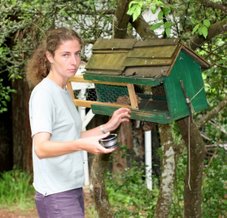
Bird in the Bag
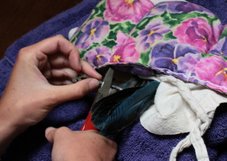
Applying a metal band
Measuring
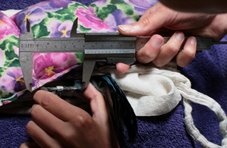
and more measuring. . . .
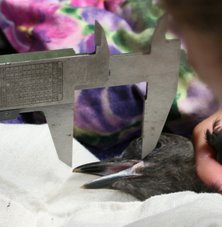
Blood Sampling
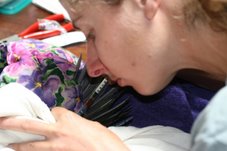
Jeff J's Work
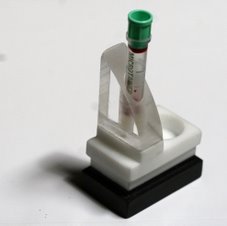
Pia's test tube holder
Weighing
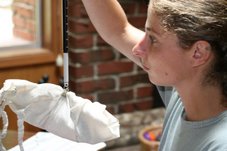
And then....release
When the sun goes down...
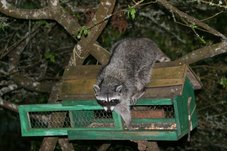
Steller's Jay Taxonomy/Description
Common Name: Steller's Jay
Class: Aves
Order: Passeriformes
Family: Corvidae
Genus: Cyanocitta
Species: Cyanocitta stelleri
Steller’s jay belongs to the family, Corvidae, in the Avian Order Passeriformes. Passeriformes is the order of perching birds. Corvidae is the jay, magpie and crow family. The Steller's jay's scientific name is Cyanocitta stelleri. The generic name, cyanocitta, means "blue jay". Its specific name, stelleri, named for George W. Steller (1709-1746). Steller was a German zoologist who explored the coastal areas of the northern Pacific Ocean in 1740.
Band Colors
black | white | purple | red | orangeBands are read in the following order:
light blue and light blue | green
Note: Light blue is difficult to read. It darkens with age, resembling a green band. (b/w/p/r/o/lb/g)
right bottom band
right top band
left bottom band
left top band
Data Collecting
This information was copied from the website of Dr. Jeff Black, Humboldt State University Wildlife Department.
The data to include for each record:
- Bird’s color code
- Size of social group seen at the same time
- Associates’ color codes (or if unbanded = UNB; or not determined = NOTD)
- Number of times associates came within 3 meters of each other
- Approximate time spent within 3 meter distance (e.g. 2 seconds, 15 sec, etc.)
- Total time you watched the birds (e.g. 5 minutes, 10 min, etc.)
- Time of day; start of observation (e.g. 1935)
- Date (e.g. 9.30.99)
- Location of observation (e.g. Rewood Bowl SW corner west bleachers. And state whether the bird was seen at a birdfeeder or in trees, etc)
- Comments (e.g. deformed leg, feather tuft on back, etc.)
Arcata Steller's Jay Sightings
Mr. Go
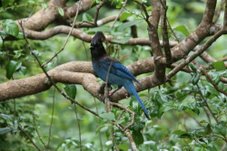
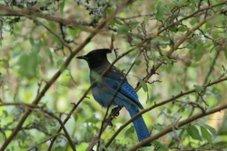
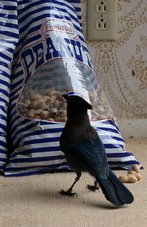
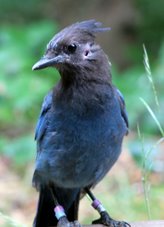
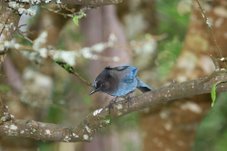
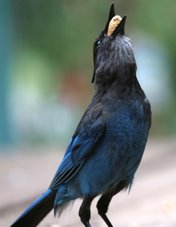
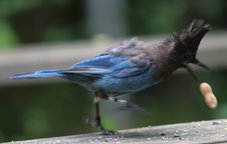
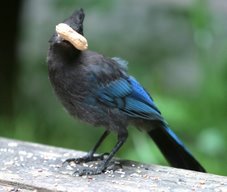
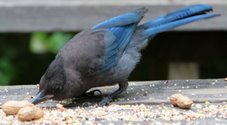
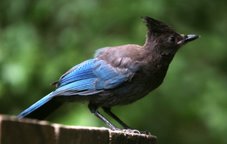
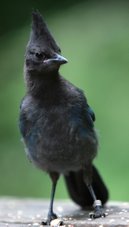

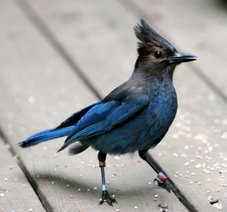
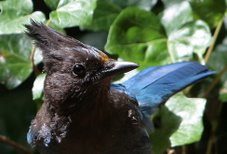
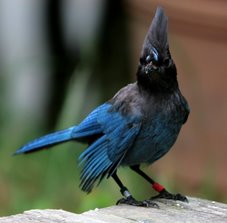
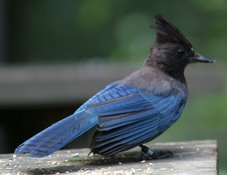
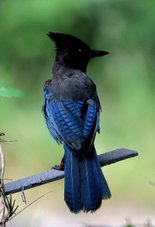
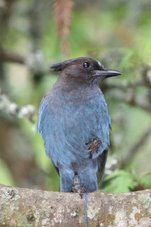
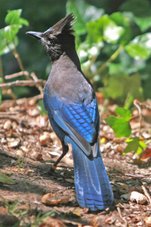
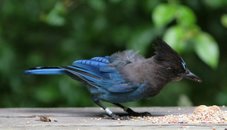
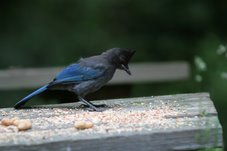
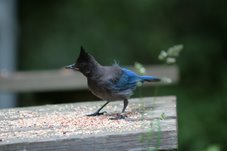
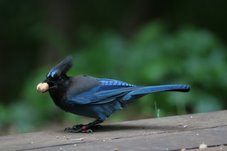
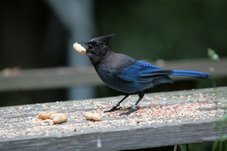
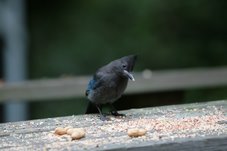
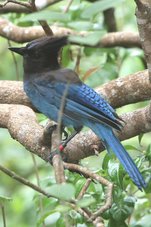
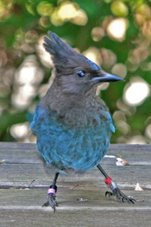
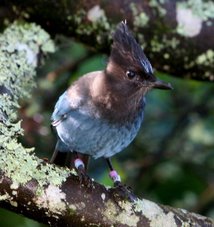
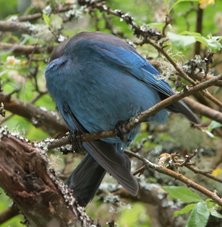
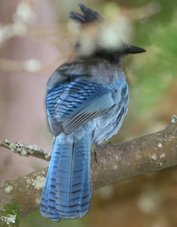
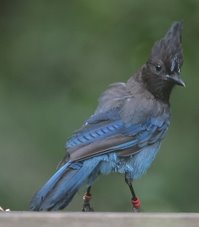
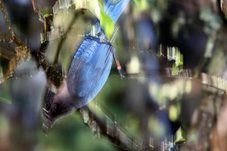
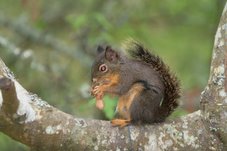
1 comment:
Hi Catherine,
Your observations are so interesting and your photos are wonderful. You really are observing such nuanced behavior.
I'm going to put your blog in my bloglines feed. Come by and see my blog too.
Post a Comment